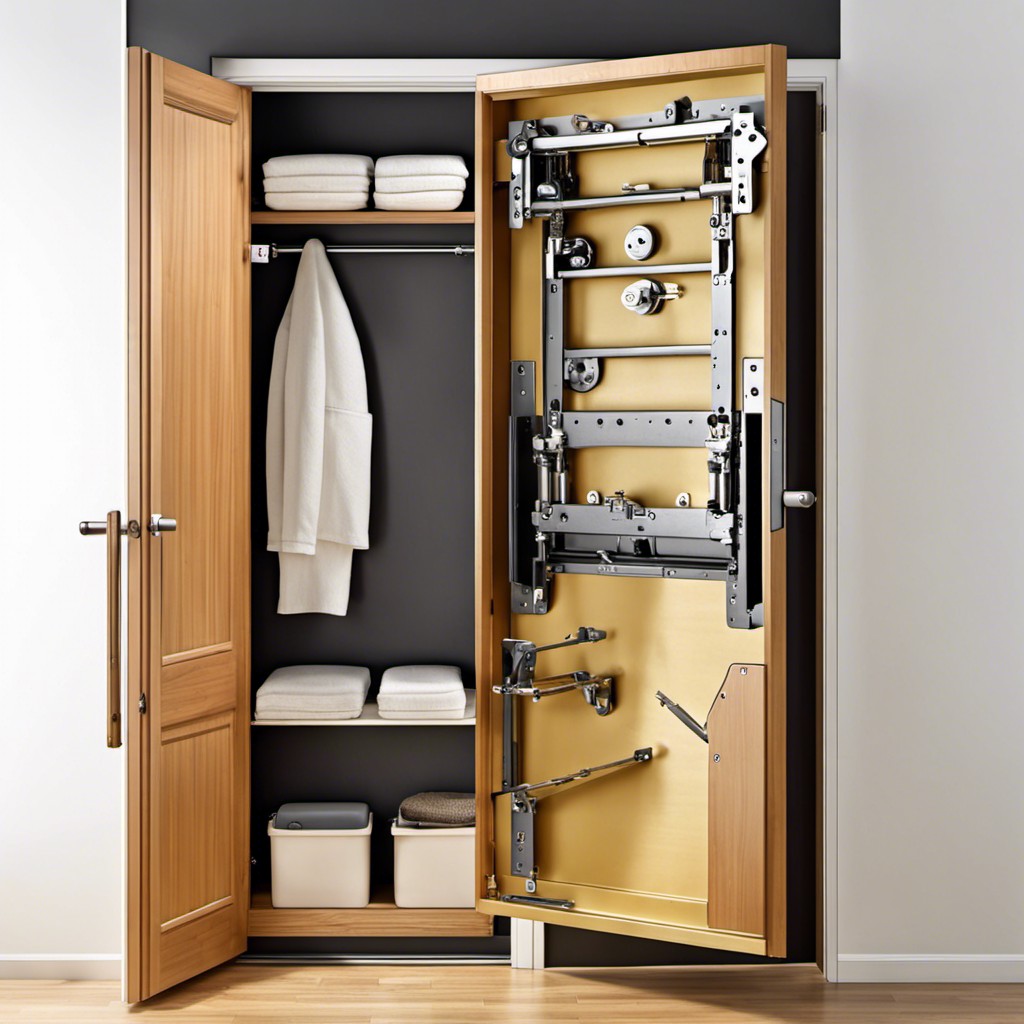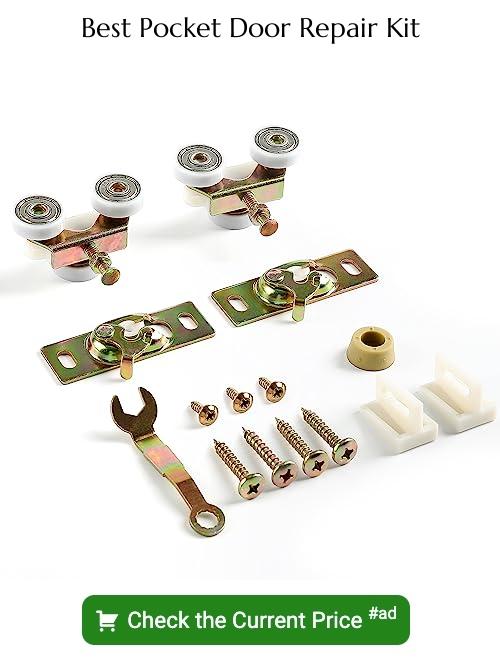Last updated on
Adjusting a pocket door without removing the frame is not only possible but it’s also less complicated than you might think, and here’s why – this article will walk you through a step-by-step process, saving you both time and effort.
Adjusting a pocket door without removing the frame is a straightforward task that requires minimal tools and time. This article will guide you through the process, ensuring you can smoothly and efficiently operate your pocket door. We’ll cover everything from identifying the problem to making the necessary adjustments, ensuring your pocket door glides effortlessly in its track.
Whether your door is scraping, sticking, or not closing properly, the solution is within reach. So, let’s dive into the details, and before you know it, your pocket door will be functioning like new.
Key takeaways:
- Understanding the pocket door mechanism: door, track, rollers.
- Tools required for pocket door adjustment: screwdriver, ladder, flashlight, pliers, level.
- Preliminary steps before adjusting a pocket door.
- Steps to adjust a pocket door without removing the frame: locate adjustment screws, make vertical and horizontal adjustments.
- Use appropriate lubricant and regular cleaning for smooth operation.
Table of Contents
Understanding Pocket Door Mechanism

A pocket door, unlike traditional doors, slides in and out of a recess in the wall hence its name. It consists of three primary components: the door itself, the track, and the rollers. The door is the movable part that provides the barrier, while the track, typically a metal or plastic rail, guides the movement of the door. The rollers are small wheels attached to the top of the door, allowing it to glide smoothly along the track. The sliding mechanism depends on the rollers running smoothly on the track, and the performance of all parts working in harmony. Any fault in these elements can cause the door to stick, make noise or jam. Adjustment is usually needed to address such issues for a seamless functionality.
Tools Required for Pocket Door Adjustment

For a successful pocket door adjustment, a handful of tools sit at the core of the process. A screwdriver emerges as a key tool, allowing adjustments to be made to the screws on the door hardware. Both flat-head and Phillips screwdrivers could be required, depending on the type of screws installed on your door.
A sturdy ladder aids in reaching the top of the door where most of the primary hardware is located, while a flashlight provides ample lighting to facilitate smooth operation. A pair of pliers might come in handy for more complicated adjustments, and a level assists to ensure the door is perfectly aligned post-adjustment.
Lastly, a quality door lubricant serves to smoothen the door’s movement within the tracks. It wards off unnecessary friction that wears out the hardware over time and contributes to the smooth overall operation of your pocket door. Always remember, being well-equipped beforehand accelerates the adjustment process and guarantees the desired outcome.
Preliminary Steps Before Adjusting a Pocket Door
Before diving into the actual process, ensure your safety and the efficiency of your work by adhering to these preliminary steps:
1. Gather your tools: Typically, you’ll need a ladder, a screwdriver, and a spirit level. Having all your tools handy reduces the back and forth, thus making the process smoother and faster.
2. Clear the area: Remove any furniture or obstructions near the door. This not only creates a safe working environment but also gives you room to maneuver as needed.
3. Examine the door: Check the door thoroughly for any signs of damage, like dents or cracks. In such cases, a simple adjustment might not suffice, and a replacement may be necessary.
4. Diagnose the problem: Is the door rubbing against the frame? Is it falling out of alignment frequently? Identifying the issue helps in knowing which parts to adjust.
5. Inspect the rollers and track: Pocket doors work on a track system with rollers. Over time, these rollers can wear down or the track can start to bend. If they are damaged, replacing them might be a better option than adjusting the door.
These steps are all about preparation. Just like a chef gathers all ingredients before cooking, these steps ensure you are fully equipped to handle the task ahead.
Steps to Adjust a Pocket Door Without Removing the Frame
1. Locate Adjustment Screws: Nearly all pocket doors have an adjustment mechanism located at the top near the door jamb. Look for a pair of screws – one controls vertical adjustments while the other affects horizontal motion.
2. Vertical Adjustments: Using a screwdriver, slowly turn the screw designated for vertical adjustments. Clockwise rotation will raise the door, while a counter-clockwise turn will lower it.
3. Horizontal Adjustments: Similarly, utilize the other screw for horizontal changes. This helps balance the door’s position within the frame. Be gradual, assessing the door’s movement after every few turns.
4. Check the Door: Maintain the door into a vertical and symmetric position within the frame. This ensures smooth sliding and proper fitting.
5. Test and Repeat: Test the pocket door’s function by moving it back and forth within the track. If the door still jumps off its track or sticks when sliding, repeat the adjustment process.
Always remember, patience is key. Making too many adjustments at once can potentially cause damage to the door or misalign it further.
Use of Appropriate Lubricant in Pocket Door Adjustment
When it comes to the efficient operation of pocket doors, the proper lubricant can be a game changer. Here’s how it works:
1. Promoting Smooth Glide: A well-lubricated track system ensures the door glides easily, reducing effort and wear on the parts.
2. Reducing Friction: Lubricants reduce the friction between the rollers and the track. Less friction translates to less strain on the components, extending their lifespan.
3. Preventing Noise: A squeaky pocket door can be a real nuisance. Lubrication helps eliminate those unpleasant sounds by ensuring the parts move together smoothly.
4. Deterring Rust: Applying a quality lubricant can also help protect against rust and corrosion, especially in humid climates or bathrooms.
Remember, not all lubricants are created equal. One should opt for a non-stick, silicone-based version that doesn’t attract dust or grime over greasy types. Applying a thin layer to the track and rollers as part of your regular maintenance ritual is key to keeping your pocket door performing flawlessly.
Regular Cleaning and Lubrication of Rollers and Track
Extending longevity and smooth movement of your pocket door is dependent on the attention given to the rollers and track. Neglect in this department might cause issue sooner or later.
First, ensure the rollers are dust-free and remove any obstructions. For effortless cleaning experience, utilize a small vacuum. Next, inspect the track for dirt or any foreign objects that could hamper door operation. Build-up can be cleared using a wire brush.
Once cleaned, it’s time to apply lubricant. Steer clear from oil-based lubricants as they attract dust and grime. Go for a silicone-based lubricant, it will keep things running smoothly without the sticky mess. From the top side of the door, liberally apply the lubricant. The gravity should carry it down into the track.
Be sure to tackle both sides of the door. Clean and lubricate the parts every few months to keep your pocket door sliding smoothly and effortlessly.
Pocket Door Maintenance Tips After Adjustment
After completing the adjustment process, apply the following tips to ensure your pocket door remains in excellent working condition long-term.
1. Regular Cleanings: Built-up dirt and grime can interfere with the operation of the door. Regularly wipe down the track and rollers with a clean, dry cloth to prevent accumulation.
2. Lubrication: Use a silicone-based lubricant for the best results. Regularly apply this to the rollers and track, facilitating smooth movement and preventing unwanted friction, which can cause the components to wear down faster.
3. Periodic Adjustments: Over time, it’s natural for pocket doors to slip out of alignment. Regular checks and minor adjustments can prevent more significant issues from developing.
4. Avoid Excessive Force: Be gentle with your pocket door. Excessive force can result in misalignment or even damage to the core components. This is especially crucial in homes with children, who may not understand the delicacy of these doors.
5. Regularly Inspect Components: Always keep an eye on the door’s hardware. If rollers or tracks seem worn down or damaged, replace them promptly to avoid bigger issues.
6. Prioritize Professional Help: If you are ever unsure, seek professional assistance. Remember, some minor issues may hint at more complex, underlying problems. It’s always safer (and often cheaper) to rely on experienced professionals than to gamble with DIY methods.
FAQ
Should a pocket door be flush with the frame?
Yes, a pocket door should be flush with the frame unless there is a finished floor, in which case, the header should be slid inside the frame by ¾”.
Can you adjust the height of a pocket door frame?
Yes, the height of a pocket door frame can be adjusted by turning the adjustment screws clockwise to raise the door, and counterclockwise for adjustment bolts.
What are the most common issues to look out for when adjusting a pocket door?
Common issues when adjusting a pocket door include misaligned rollers, worn-out hardware, warping, and accumulated dirt in the track.
Can pocket doors be adjusted without professional help?
Yes, pocket doors can be adjusted without professional help by loosening the adjusting screws on the hanger brackets and manually moving the door until it hangs evenly, before tightening the screws back in place.
What are the tools required for the adjustment of a pocket door?
To adjust a pocket door, one would require a screwdriver, level, wrench, and a hex key or Allen wrench.





